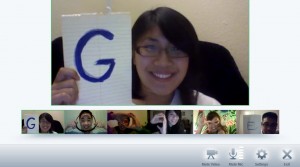
Young people already having fun in "Hangout" the killer video app that will drive mass adoption to Google+
My introduction to Google+ was by way of watching yesterday’s episode of TWiG, which featured Bradley Horowitz and Vic Gundotra, the two leaders of the Google+ project.
But what caught me, got me really excited about Google+, happened in the minutes before the show actually started. Leo jumped on a feature of Google+ called “Hangout,” an instant video conferencing application that is automatic, and which can include up to 10 people from your various “Social Circles.” What immediately jumped out at me was how FUN, spontaneous, and effortless it seemed (as well as being productive). You don’t have to place a call to someone or schedule a video chat. If you see someone “hanging” out you can just jump right in, sort of like the serendipity of jumping into a Twitter or Facebook conversation (known as dipping in and out of the “stream”). But those are text, and this is VIDEO, and that makes a big difference. Leo’s first friend who “popped” into his video hangout was Trey Ratcliffe, noted photographer, and for some reason, watching it, there was this surreal feeling that Trey (who happened to be in Chicago I believe) was actually inside the computer, like behind a cardboard cut-out, instead of being thousands of miles away. It made me think of all those hundreds of avatars I see each day on Twitter or Facebook, if they could suddenly come alive, instead of being frozen as they are in still photos. Suddenly the internet had “come to life,” as it were. A marvelous feeling. Among other things that are great about Google+, it seems more “alive” than the other social networks. More living, breathing. And “Hangout” is a big reason why.
Leo said it himself, almost spontaneously, that Hangout was one of the coolest things he’d seen in a long time, and I agree.
The rest of Google+ is beautiful, engaging, and full of potential, but Hangouts is the killer app, I believe will drive mass adoption.
So the conversations around Google+ were inevitably “Will it kill Facebook? Will it Kill Twitter?”
That question remains to be seen, but I think folks nitpicking this feature compared to that feature, and on and on, are missing the BIG PICTURE.
The big picture is what Google is after, and I would argue has the most vision about, and the most resources to execute.
The Key here is that the Whole is greater than the sum of the parts.
If you take the individual pieces, you could say Twitter is better at what it does, Facebook is better, and Apple is better with it’s mobile OS. I think it’s fair to say that each of their individual pieces is better than the individual pieces of Google’s platform, albeit, just from one evening with Google+ it seems to be every bit as good as Facebook and perhaps better especially with the Hangout feature and the Social Circle feature, which makes it FUN to create lists. No one wants to create lists, but everyone likes to have them. And one more thing about creating “Circles” Did you notice how “Applely” it feels to drag so easily your contacts into the circles. It has the same feel as dragging things on OSX. A prime example of how an operating system can execute with the same feel as a desktop system. One little nudge in Chrome’s direction (Another piece of the puzzle)
But the key here is that Google has all the pieces. Think about it. Neither Twitter or Facebook has a mobile OS. Google does. Apple has an OS but doesn’t have a Social Network, nor the back end Cloud Syncing Data capabilities that Google has. This is why Apple and Twitter are having a “shotgun” wedding in iOS5 and why Microsoft is engaged with Facebook. But these types of “bolted” together arrangements rarely work. Two different companies, two different cultures. But still you get the point: These other companies don’t have all the pieces to bring together the new paradigm of the Web and Mobile being the new productivity platform. Google does have all the pieces. Their “jigsaw” puzzle type logo is now making more sense.
This isn’t just about a Social Network. This is about a platform of services that are tightly integrated.
What became clear to me last night is that this isn’t just about Google+ (as great a product as that is and will be), it’s about the fact that, with this launch Google has, in effect, reduced or ‘highlighted’ Twitter and Facebook-type functions as mere applications, powerful and important as they are, within a much greater whole, but not platforms. In a sense, they are apps without a platform and Apple is a platform without an App. I know that sounds silly with what all the hundreds of thousands of apps in the App Store, but what I mean is a data app, a cloud app, an app to Data Productivity Services that syncs all of your data immediately in the Cloud, as well as to a Social Network, which I am arguing is simply an “App” of this new Cloud Computing World. Apple Apps are wonderful, beautiful, but they are in a sense isolated islands.
Why is the Cloud so important and why is it considered the leading paradigm? The “Cloud,” as it were, marries the two most important aspects of the data revolution: Automation (Micro Electronic Revolution) + Distribution (The Telecommunications Revolution). Light and Electrons. Electrons for storing and automating data, photons for delivering, communicating, distributing data. The Cloud is needed to leverage the exponential productivity gains that comes from combining these two separate technologies. Each separately have given us productivity gains as great or greater than even the Industrial Revolution. But together the productivity gains are even exponentially more so. One which both businesses, individuals, governments, and society alike find opportunity and achieve higher standards of living.
Apple is trying with iCloud, but does anyone actually think they have the ability to compete and execute on that front (or maybe I should say ‘back-end’) with all the Data Centers and Engineering expertise in the Cloud that Google does? I don’t. At all.
Last night Scoble scoffed, “Hangouts is kinda cool.” Kinda Cool? What? That’s it? No other company on the face of this Earth could emulate what it takes to make that product happen at scale. Facebook can’t simply copy that feature. They don’t have near the resources or engineering to do it. Not to mention Twitter. Apple has the cash, but I’d argue, it’s not in their DNA. Apple likes to sell things, not connect things. Cloud Computing is not their forte, their passion. They’ll endure it, but I don’t see the product or experience as being particularly promising.
But let’s not get bogged down by individual features. Let’s look at the big picture. Google is the only company that has all the pieces of the puzzle, and as they bring these pieces together, it will invoke a value proposition that users would be depriving themselves of if they didn’t join.
Think for a moment about what I said about Facebook not having a mobile OS. It’s simply an app on the OS that you have to open each time and load your photos manually.
With Android tied to Google+ all of these signals, including photo uploads happen automatically. And that’s just the Social Network aspect, the social signal: Automation.
Google has a plethora of other invaluable services, Maps, Gmail, Location, Search, Music, Video, Cloud back up, automatic effortless syncing, and on and on. And they’ll continue to add productivity and all the categories of apps that people find useful. And with an OS that is tightly integrated with those services, I don’t care how beautiful your hardware is, how beautiful the interface is (I love my iPhone by the way), I’d bet my bottom dollar even diehard iPhone users will think long and hard about what their next phone is going to be, and in a year or two their tablet as well. Google is building and connecting a platform that essentially is the most valuable “content” for mobile computing and experiences. Even when they get around to an iPhone app, the experience won’t be nearly as robust as if one were using it on an Android device.
From this vantage point, Twitter and Facebook are looking a lot like Lotus and Wordperfect did in the 80s. Even though Microsoft Office wasn’t as good when it first rolled out, it iterated and became “good enough” then as good and then better. And the momentum was the integration and trust that came from the suite being tied to the OS.
The same will happen for Chrome, Android, Google Services, and Google Productivity suites all driven by the powerful backend, unmatched backend of Data Centers, the Cloud, and their unmatched expertise in those areas.
Before, Google was the backend that needed Apple for distribution. Now with Bradley Horowitz designing a beautiful front end for Google’s interface they have their own distribution channel, and a way to bring all of their enormous resources to bare in the marketplace.
Is Twitter dead? Is Facebook dead? Or Apple? No, not by a longshot. All of these companies are run by innovative geniuses who are not going to spit out the bit like Myspace. This will be a horserace, and a damn good one, but if I were placing my bets today, I’d say Google will win by a nose at the wire. They’ve always had the best horse. And now they have a winning jockey.
But in the end, the essence of the web is not a zero sum game. One can imagine all of these companies growing, being prosperous, and what’s more important, imparting enormous benefit and productivity gaines to civilization, all without having to annihilate each other. I’d say Myspace went down for lack of vision, lack of focus. In other words, not because of Facebook, but because of themselves.
John Wooden used to say that he rarely scouted the competition, that instead he focused on he and his team competing with themselves to get better. Twitter, Facebook, Apple, and Google all have this same drive and spirit. And what would be better than one defeating the other, is if they all constantly innovate, are “into” it, and in effect, all win.
Update: 7/2/11: I’m kind of angry. Today Tom Anderson wrote the following on G+, which is my same idea, yet it got an enormous headline on Techmeme via being copied in a post on Mashable. Kind of makes me mad, because I wrote this post on Thursday and sent it to Techmeme. On the one hand they must have put a small link to my post because I did get some traffic from techmeme, but nothing like a big headline they are giving Tom. Well, I guess that’s life. Tom is Somebody. But still, the idea is exactly the same as mine and yet they gave barely notice, but now that Tom said it, it’s the talk of the town, so to speak.
“Google+ seems like a “reaction” to Twitter/Facebook. But are you starting to see the ways that Google+ just makes Google a better, more integrated set of services? Google already has top-notch products in key categories–photos, videos, office productivity, blogs, Android, maps and (duh) search. Can you start to see/imagine what Google+ does for Gmail? Picassa? Youtube? Not to mention search? The +1 system that Google now has control of (unlike Facebook Likes) can really influence and change the nature of their search.
My original vision for MS was that everything got better when it was social–so I tried to build all the super popular things used on the web (blogs, music, classifieds, events, photos) on top of MySpace’s social layer. When Yahoo launched 360, MSN launched Spaces, and Google launched Okrut, I was shakin in my boots. But quickly I saw that it’s really hard to layer in social to features after the fact. At MySpace we had the luxury of having social first, and building the products on top of that layer. Then I choked and Facebook realized that vision. 😉
But Google+ really seems to be primed to make good on that original premise–that everything gets better when its social. And unlike FB, Twitter, or anyone else, Google already has the most advanced set of products. And if I can clearly see where this is headed, then I think what we are getting is a much better Google. Does that kill FB/Twitter? Who cares? I’d use all 3, but more importantly, I’ll be using Google products I never used, or use them in new, better ways I never used them before.
Oh yah and I love my Google TV :)”
–Tom Anderson, Founder of Myspace in a post on G+ on 7/2/11
More interesting reading:
Gina Trapani – Smarterware.org – What Google+ Learned from Buzz and Wave
Google+ Everything You Need to Know – TechRadar.com
Finally Getting Google – BigEvidence – Thom Kennon
Ad Free Google Plus 50 – Chris Brogan
The Top Google+ Tips and Tricks – Ranker.com
Is Google Hangouts It’s Killer App? – Nytimes.com
Google+ Improves on Facebook – David Pogue Review for the NYtimes.com
Google+: The Complete Guide – Ben Parr for Mashable.com
10 Things CMO’s Need to Know About Google+ : Chris Brogan writing for Forbes.com
Google+ is the Social Backbone – Ed Dumbill – O’reilly Radar
 Man, I haven’t blogged in forever. I think about it too much. One shouldn’t think, one should just blog. Blog’s aren’t formal.
Man, I haven’t blogged in forever. I think about it too much. One shouldn’t think, one should just blog. Blog’s aren’t formal.



